|
We crossed the Sand Ridge and took
a road through a mopane woodland. We went for a long way without
seeing any animals. The trees were much larger here because the
elephants just pass through seasonally and don’t stay to eat
them. We were seeing more water now; there must have been a lot of
rain recently because there were huge puddles in the road.
Sometimes these water-filled potholes were enormously deep, but
Gee navigated them expertly.
After a long stretch with no wildlife, we passed several
elephants and a giraffe. Soon elephants started popping up
everywhere, emerging out of the cover of the trees into the road.
We had to stop numerous times to wait for them to cross the road
or allow us to pass.
Then more giraffes started
appearing, casually strolling into the road and stopping there,
watching us with benign expressions. We were busy dodging
water-filled potholes, elephants and giraffes at every turn. Two
especially beautiful giraffes stopped in front of us and stood
with crossed necks. (We noticed the giraffes’ manes were short
and tidy - they seemed to be well-pulled. Still, it would be quite
a job to braid them!)
A herd of elephants wandered into the road and Gee cut the
engine so we could watch them quietly. More and more moved in, and
before long they were all around us - we found ourselves
surrounded by over thirty elephants. One of them seemed a little
mad; he flapped his ears at us and trumpeted, moving toward us
threateningly. Time to
go! Gee went to start
the land cruiser: click, click – would it start? Fortunately it
did, but only after several tense tries.
Before long we started to see zebras mixed in with the
giraffes. Gee told us they hang out together because zebras can
see better down in the thickets and giraffes can see for long
distances from their great height – the partnership keeps them
both safer.
There were fewer large trees here. Gee pointed out the tall
grass with whispy heads called fingergrass; he told us it brings
grazing animals to the area.
‘My God!’ Gee exclaimed,
and pointed. A pair of Coqui Francolins was crossing the road;
they were beautifully marked and much prettier than the ubiquitous
crested francolins. Gee told us this was only the second time he
had ever seen these birds.
|
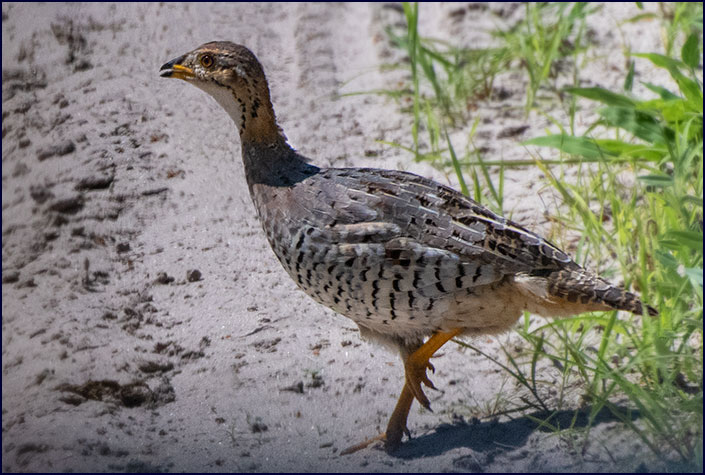
Coqui Francolin
|
We came out of the woodlands to the edge of a vast plain,
the Mababe Depression. This shallow basin was once part of a huge
lake that used to cover much of northern Botswana, connecting to
the Savuti Marsh and the Makgadikgadi Pans. Now it is grasslands,
and home to large herds of animals.
We
drove out onto the open plain and stopped for tea beside two
lonely trees that grew in a V shape; I recognized this as our
lunch spot on the two previous trips. There had been another tree
nearby with tsessebes under it on our first visit, but now it was
just a dead log on the ground– the work of elephants, no doubt.
A yellow-billed hornbill came and begged for food, hopping
around on the ground in front of us and tilting his head up
beseechingly; we were obviously not the first people he had begged
from. Soon his wife joined him, along with their four kids; when
the adults found a crumb they would feed it to the adolescents.
Gee explained that it was important that we not feed the birds;
when given people food they can get so hooked on it that they
spend all their time waiting for handouts instead of hunting for
food in the wild, and that can cause them to starve to death.
|
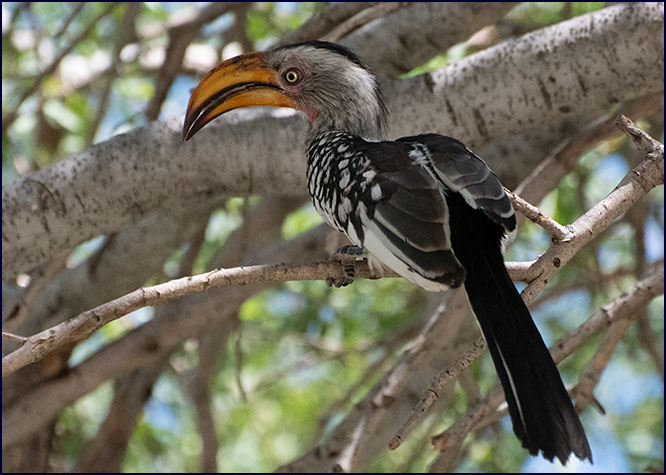
Yellow-billed Hornbill
|
After tea we
went back into the edge of the woods, following the road that
skirted the plain just inside the trees. There was not a lot to
see here. Eventually the road came back out into the open, and we
drove along the edge of the Mababe Depression.
There were thousands of zebras spread across the plain. Gee
said this is the second largest animal migration in the world, and
that 3000 zebras migrate each year from Chobe. They were broken
into smaller herds and family groups.
The zebras went on for miles and
miles. It was an amazing scene; the green grassy plain, fluffy
clouds dotting the blue sky, and zebras as far as the eye could
see. Earlier I had hoped to see more zebras; I had clearly gotten
my wish!
There were many waterholes, and zebras were gathered around
each. Some were drinking, some were grazing, some were playing and
some fighting. We watched zebras chasing each other, running in
circles, splashing in the mud and standing scratching each
other’s necks. There were several very small babies just a few
weeks old; we watched them nurse from their mothers. I was in
heaven.
There were wildebeests among the zebras, though in far
fewer numbers. We also saw warthogs at every turn. We watched a
mother warthog with three babies grazing on their knees, and
wondered who ate the fourth. We could see some black dots on the
horizon, shimmering in the heat waves; they turned out to be half
a dozen elephants, quietly walking toward us across the plain.
A large female Spotted Hyena was lying in a mud hole near
the road, trying to cool off. She had a full stomach, or perhaps
she was pregnant. She seemed sleepy. When we stopped to watch her
she got up and walked sedately away, looking back over her
shoulder at us in admonishment for interrupting her nap.
Gee spotted two lionesses sleeping under a tree; it was a
good spot as they were hard to see, hidden in the shade and brush.
They had full bellies as well, so no hunting for a while.
Dozens of wildebeests were lying in the shallow water along
the edge of a large waterhole, along with several babies. About
fifty zebras grazed nearby, and some of them made their way down
to the water to drink. Warthogs were rooting around in the mud in
front of them, and the elephants we had seen on the horizon had
moved closer now, along with a couple giraffes.
A whole group of the zebras started running, chasing each
other. They galloped back and forth along the shore of the pan.
The elephants walked by in a dignified manner, ignoring the antics
of the foolish zebras. After considerable scrutiny, a giraffe
splayed out his legs and lowered his long neck to drink from a
puddle. It was a fantastic scene.
Two zebras started fighting in earnest; they reared and
crashed into each other, biting and pawing. Gee told us it was
probably a young male zebra challenging the herd stallion hoping
to earn one of his daughters. They need to be strong enough to
challenge the father to be allowed to breed.
All in all, we spent two and a half hours crossing the
Depression, watching zebras, wildebeest, warthogs, elephants and
giraffes the whole way. No cheetahs though; we had hoped to see
them here. Gee said when we went to the Kalahari later in the trip
we might have a chance to see them.
It was midafternoon by the time we came to the Mababe Gate.
We drove fast on one of the larger sand roads, and then turned out
onto the wash-boarded and dusty gravel main road. After a while
Gee turned off to the left on a little lane.
This track got smaller and
smaller, and became increasingly wetter. We had several deep water
crossings where we had to pick our bags up off the floor in case
the land cruiser flooded. And all this with the luggage trailer in
tow.
We passed several elephants and
what seemed like hundreds of wide deep puddles. Each one we
crossed was deeper than the last. It was a road of water! We hoped
the luggage was not getting too wet. This was definitely not the
way we had gone to Khwai before, we thought. Where are we going?
Suddenly we drove out of the woods into a wide green field
beside the Khwai River. The landscape was quite different from
Savuti, much lusher, and with more water everywhere. There were
some scattered trees, and the grass was thick and tall. A herd of
elephants were walking across the floodplain toward us, and some
were already crossing the river.
More elephants came; a breeding herd, mothers with their
offspring. There was one very tiny baby; the elephants were
protecting it, shielding it from our view. Then another herd came
into view, with many adolescents and another small baby. As they
crossed the river the youngsters splashed and rolled in the water
with delight – and a few of the adults did too. They just kept
coming; soon the floodplain was scattered with elephants, over 100
of them. A huge female, the herd matriarch, strolled by keeping a
wary eye on us.
They kept on coming. Another breeding herd arrived, with
yet another tiny baby. When they crossed the river the little one
was totally submerged, with just his trunk sticking up like a
snorkel.
Many of the elephants stopped to play in the river,
wallowing and splashing like they were in a spa. Two young males
stood face to face, pushing and shoving each other while
play-fighting. One small baby was missing his tail; we figured a
crocodile must have gotten it, or possibly a lion – either way a
close call. An adolescent male mock-charged us, trumpeting angrily
while he flapped his ears and waved his trunk; Gee said he was
trying to be the big man.
The riverside seemed to be a meeting place where four or
five herds all came together. Now there were over 200 elephants
spread across the floodplain. We had never seen anything like it.
Even Gee was impressed. How did he know they would be there?
Amazing!
At four o'clock we had a late
lunch by the river, watching the elephants. We headed out at 4:30,
just as yet another herd was arriving, also with a very young
baby. We had seen more tiny baby elephants in the last hour than I
had on all of my previous trips put together!
We went back out to the main road for a while, then finally
took the turnoff toward our camp. We were now in the Khwai
concession area, and the landscape was quite different. Savuti is
much drier and more arid (though there are plenty of waterholes in
the rainy season), but now we were near the edge of the Okavango
Delta where everything is wetter and more lush. Different animals
and birds could be seen here.
A female Waterbuck was walking through a meadow. These
fluffy antelope look like a larger furrier version of our deer,
with a white target-like circle on their rumps. The males have
long twisting horns. There is something very appealing about them
– they have an almost cuddly appearance.
|
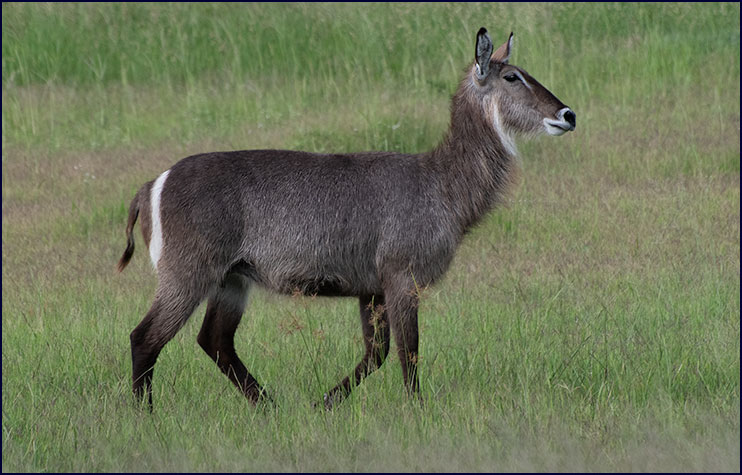
Female Waterbuck |
It was getting on toward evening as we drove alongside the
Khwai River. The floodplain was a wide green expanse, wet and
marshy this time of year. Three parks come together here: we had
left Chobe National Park and were now in Khwai, and we could see
Moremi Game Reserve on the other side of the river.
A Hippopotamus raised his face up out of the water and
regarded us suspiciously, and then a second hippo joined him. They
snorted at us and then disappeared again beneath the surface. A
tall slender African Darter stood by the edge of the river,
reaching up with his elegant neck and long sharp beak. A slaty-black
color, he had a chestnut throat and a thin white racing stripe
along his neck.
A herd of Red Lechwe was grazing in the marshy grass. These
unusual-looking antelope are a bright reddish chestnut color over
the tops of their bodies, fading gradually to lighter chestnut on
their flanks and white on their bellies. They are built very
downhill, with front legs shorter than hind, and have curved
twisting horns. They love the water, and they run into the flooded
areas to escape predators. They are quite prevalent in the Delta
and we encountered them often. The lechwe are Gee’s favorite
antelope.
|
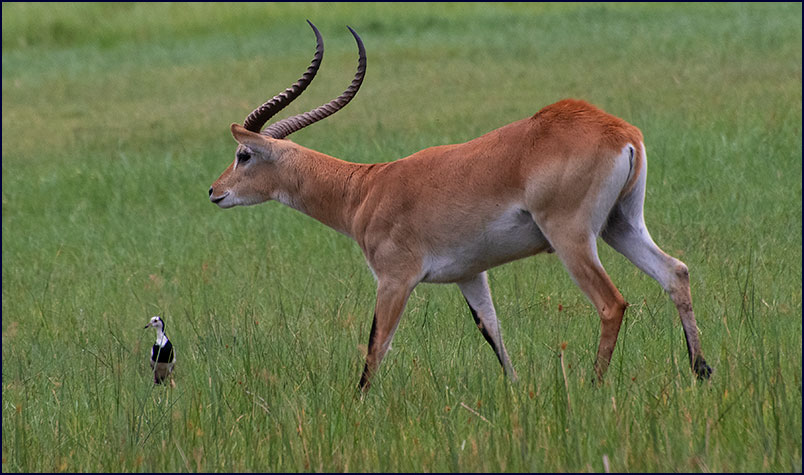
Red Lechwe |
A Pied
Kingfisher was sitting on a branch. These large black and white
kingfishers hover like a helicopter scanning the water and then
dive in for a fish. We heard the haunting cry of a Fish Eagle
wafting down from; he was flying high overhead.
These regal birds are black with white heads, and look very
like our bald eagles.
A pair of dainty
Double-banded Sand Grouse walked in the roadway.
|
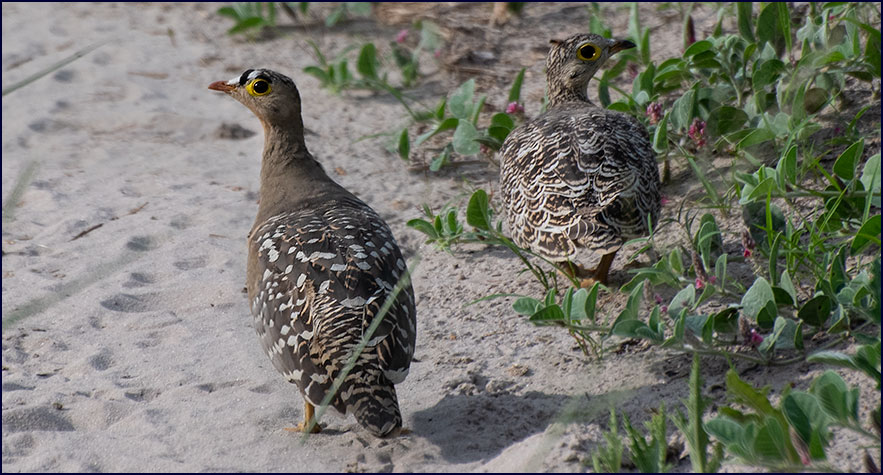
Double-banded Sand Grouse |
A Goliath Heron slowly waded along
the edge of the water, the largest of the herons. He was a lovely
bird with a slaty grey body and a variegated reddish-brown neck.
He looked very elegant and dignified.
|
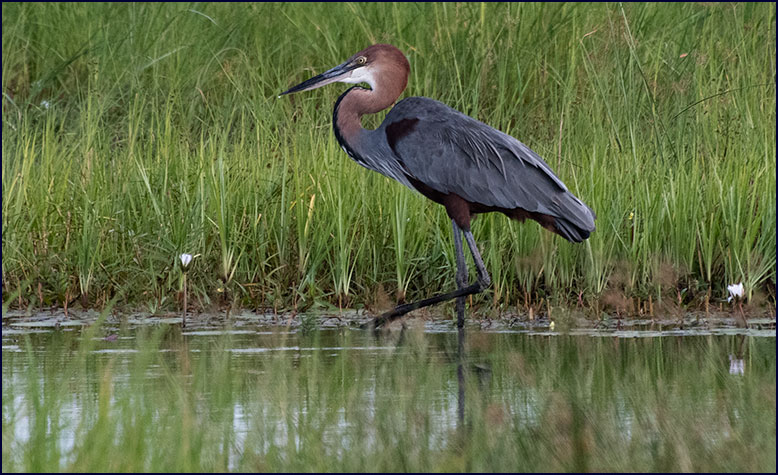
Goliath Heron
|
The light was fading as we drove through a huge area of
dead trees that had been killed by elephants. There were impalas,
zebra, wildebeest and birds by the dozen. We passed another hippo
pool; the half dozen occupants were accompanied by a Nile
Crocodile floating in the water. An elephant crossed the river,
and several more wandered along the floodplain. Several kudus were
standing alert, staring across the field, and we could here
impalas snorting the alarm call. We looked around, hoping for wild
dogs. Mary said, I wonder
what will happen next?
What happened next was Tara suddenly called out to Gee to
stop - she had seen a Leopard! It was a big male, lying flat out
on his side sleeping in a little side road a hundred meters away.
He was not easy to see; great spot, Tara (pun intended). He raised
his head and turned to gaze at us. After a few moments he sat up
and scratched, and then stood up and walked quietly away, fading
into the dusk.
A go-away bird sat on a branch, silhouetted dark against
the sky as the last light faded. We arrived at our new camp as
night was falling, and we were tired. The warm glow of the
campfire beckoned us, and we heard the crew whistling and cheering
as we approached – this camp staff was so outgoing and fun! Mike
gave a piercing whistle back at them, and we all cheered.
|
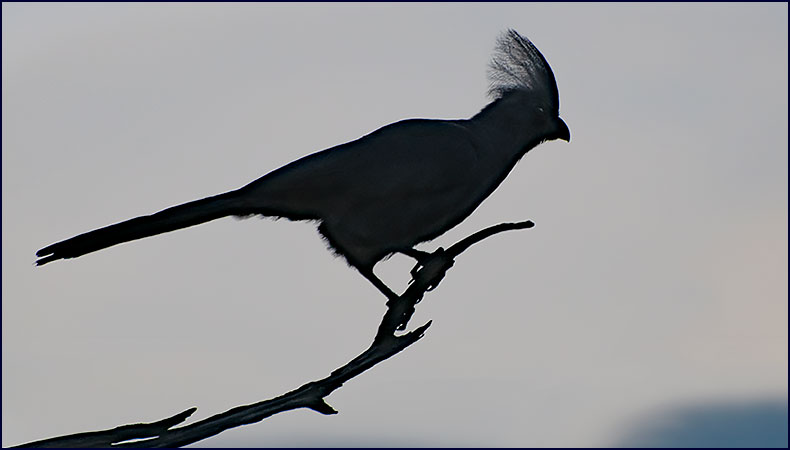
Go-away Bird
|
It was a pleasant and very private camp under some big
trees, with woods all around. Not that we spent much time in camp
anyway, between the early starts, short lunch breaks and long
evening drives. We had dinner at nine; we were not all that hungry
since we’d had such a late lunch down by the river with the
elephants. We could hear the hyenas calling during dinner. All
through the night we were serenaded by the wonderful, ridiculous,
laughing, honking calls of the hippos in a nearby lagoon.
February
11
We slept in until five-thirty and
were on the road at six-thirty for our mokoro excursion. There
were plenty of birds out this morning, such as the Fork-tailed
Drongo and the Willow Warbler. Gee was driving along at 30 mph
when he suddenly braked to a stop and said ‘new bird,’ and
pointed out a tiny black bird we hadn’t seen before - a Village
Indigobird, which he identified by hearing its song. How he does
that is a mystery!
Mokoros are flat canoes guided
with a long pole, the traditional mode of transport around the
Delta for the local people. It was sunny and clear when we climbed
into the mokoros around 7:30, and a bit on the warm side. It was
two of us to a mokoro, along with a guide/poler. The water was
calm and clear like a mirror as we set out upstream, gliding along
peacefully. Natalie and I shared a canoe, and Tara and Jineen
floated along ahead of us. Mary and Paula pulled up alongside, and
Mike and Sally drifted by serenely as we were all propelled by the
long poles, expertly wielded by our mokoro guides.
Some Egyptian geese flew over with rasping cries. An
Open-billed Stork sat in a tree beside an African darter. The
stork was heavy and thick-billed, in contrast to the slender and
graceful darter, who gripped the branch with unlikely looking
webbed feet.
|
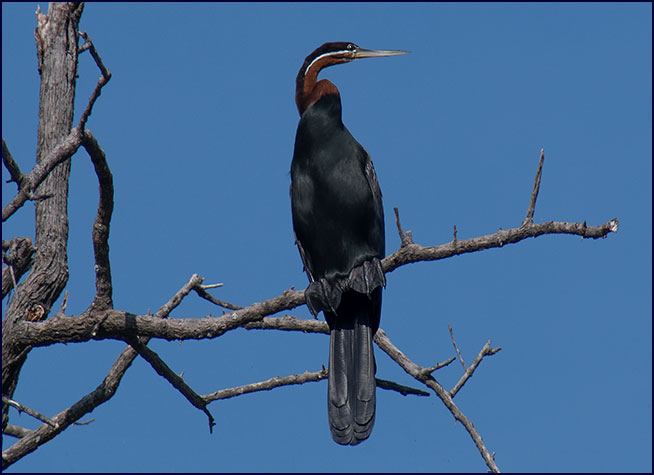
African Darter
|
There were water lilies everywhere; we learned that the day
lilies are white with a little purple and a smooth pad, and the
night lilies are cream with yellow, and have pads with spiked
edges. The roots and fruit of the lilies are edible by people and
baboons, but the elephants eat the roots only.
|
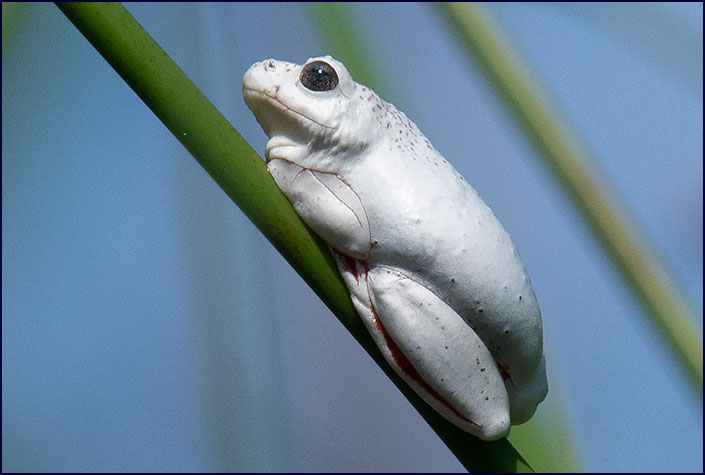
Painted Reed Frog |
Our mokoro guide pointed out a beautiful little brown and
white frog about an inch long, sitting on a reed. It was an Angola
Painted Reed Frog, also playfully called a Delta leopard. A Reed
Cormorant perched at the top of a tall dead tree. There was a huge
fish eagle nest up in a tree, with dozens of small weaver nests
hanging all around it.
Several Jacanas were running
across the surface of the water on top of the lily pads. These
long-legged wading birds are aptly nicknamed lily-trotters. They
are a bright coppery color, with white heads, black eye-masks and
sky blue on the top of their heads.
There was a pod of hippos ahead of us, and the big bull did
not want us to pass. He reared up out of the water and threatened
us, opening his mouth impossibly wide to display his fleshy gums
and long, scraggly dagger-like teeth. An angry hippo can easily
capsize a mokoro, so we turned around and didn’t mess with him.
|

One of our Polers
|
We had tea on shore, using an overturned mokoro as a
serving table. One of the boat guides wore a big palm-like leaf as
a hat. When we headed back downstream the fish eagle perched
majestically near his nest. We saw another reed frog, this one
pale white. An open-mouthed stork flew in for an awkward landing
in a tree. We were back to Gee and the land cruiser by ten
o'clock.
We saw a Hamerkop wading at the edge of a puddle. A bit
bigger than a crow, they are the brown-grey color of mud. Heavy
beaks and thick feathers on the back of their heads give them a
hammer-like shape, but somehow to me they appear gentle and kind.
There is something about them that is very appealing. Gee told us
that these distinctive birds are not closely related to any
others.
|
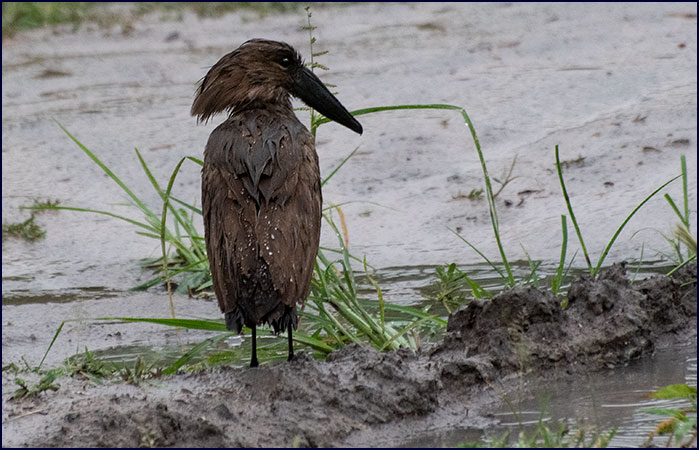
Hamerkop
|
We were driving through a wooded area when Gee suddenly
stopped and said “Look at the leopard.” Sure enough, there was
a female leopard, lying flat out on her side sleeping by road. She
raised her head to look at us, and then groomed herself for a
while. She did not seem to mind our being there. She stood up and
walked a few yards before flopping back down to continue her nap,
rolling on her back like a dog who wants its tummy scratched. A
few more yawns and a little more grooming, and she sat up again.
Her face was beautiful, refined and feminine, and her eyes
were green. I have always thought leopards should
have green eyes, but this was the first one I had met that
actually did. She had an impressive set of long white whiskers.
After a while she got up and walked off through the grass; Gee
followed at a respectful distance. She paused to drink at a
puddle, and then moved deeper into the woods. She stopped by a
tree and stood like a statue. She was exquisite.
The leopardess moved into a thicket, and we could see her
pounce on something - Gee said perhaps a snake. Then she settled
to wash herself some more. Gee told us that a female leopard’s
territory stretches for 2 to 3 miles in each direction. A male’s
territory covers that of several females. Our leopardess was still
in her mother’s territory, as she was too young to have her own.
We were quite pleased to have seen two leopards, despite
the tall grass making them harder to find. The leopard talisman I
gave Gee must be working!
We passed a group of zebras; one of them had a young foal,
less than a month old – it was the closest we had been to one so
small. He still had motley black patches on his face, which would
disappear into stripes as he got older. Gee said they were
Burchell's zebras, a subspecies of the plains zebras, identifiable
by their shadow stripes.
We passed the campsite we had stayed at on our prior trip;
we recognized it by the old mokoros sitting at the entrance, and
we could see the tree that the fish eagle had greeted us from each
day. Gee told us it had been a mistake that we camped there; the
Park had given our reserved campsite away to someone else so they
let us camp there, but it was no longer used as a campsite.
Gee drove across the Khwai River.
We were not sure we would make it through the deep, long stretch
of water, but the land cruiser plowed across valiantly. But on the
other side the ground was too wet and there were no tracks, so we
crossed back.
We drove alongside the river. The sky was blue, with puffy
white clouds. We could see hippos popping their heads up, and
pretty little white-faced ducks swimming among the lily pads. A
Little Egret and a Little Grebe walked among the tall grasses
lining the river.
A Vervet Monkey sat high in a tree with her tiny baby
clinging to her front; we could just see his hands around her
back, and his little face was pressed into her chest. A comb duck
perched awkwardly on a tree branch, looking completely out of
place. A warthog was taking a mud bath, immensely enjoying his
wallow.
|
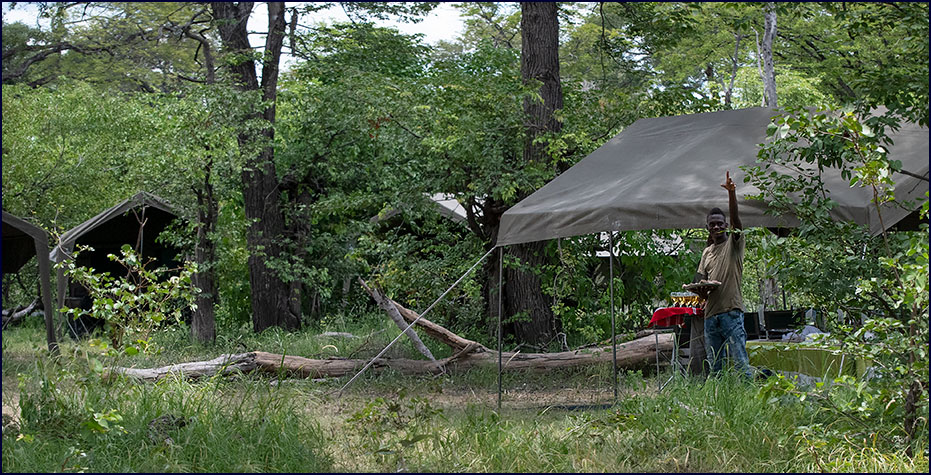
Camp
|
We were back to camp for lunch just after one o'clock; as
usual KK was waiting with the moist towels to wipe away the road
dust, and BD with our drinks. The table was decorated with soda
cans, sliced and bent into vaguely floral shapes.
I was pleasantly surprised by how
nice the weather was. We had seen a few rainclouds and several
storms in the distance, but on the whole it had remained pretty
dry, and had not actually rained on us. I jokingly asked Gee,
‘Does it ever rain during the rainy season?’ This was a highly
unpopular comment, and I was later made to eat my words several
times over.
We set out again for the afternoon drive around three
o'clock. When we left camp BD and JJ, knowing we would be doing a
night drive, said to us, ‘See you later – much
later, ha ha, like see you tomorrow!’ Little
did we know that we would be seeing them in less than an hour.
We drove along the river again, enjoying a myriad of
interesting new birds. Some of the highlights were the colorful
little Golden-breasted Bunting, the black and white Arnot's Chat,
and a pair of blueish green Swallow-tailed Bee-eaters. We saw a
Green Wood Hoopoe in a tree – these lovely birds seem somehow
mysterious to me.
|
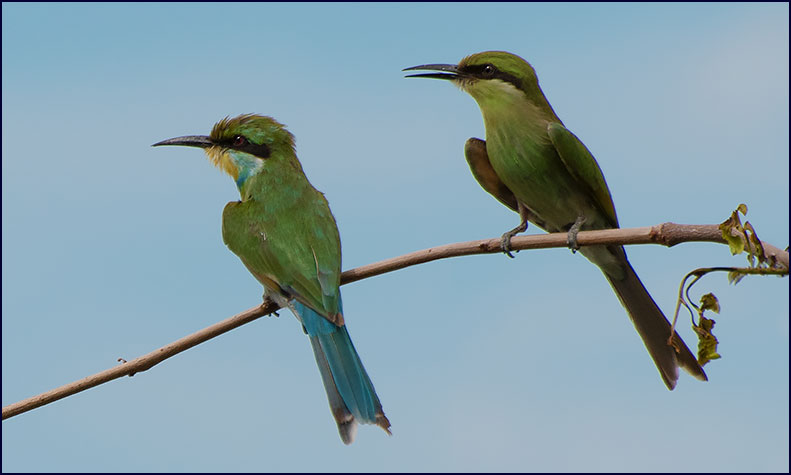
Swallow-tailed Bee-eaters
|
A Green-backed Heron sat on a stump along the river. A
father jacana and his chick were walking across the lily pads. The
polyandrous jacana father takes care of the chicks once they
hatch; meanwhile mom goes off and mates with someone else. An
African hawk eagle perched on a branch close overhead; he had a
hooked beak and fierce yellow eyes.
|
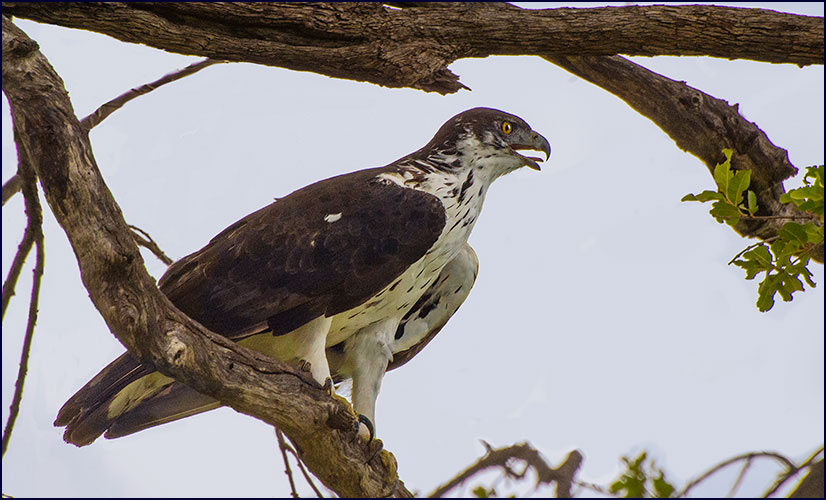
African Hawk Eagle
|
A large hippo watched us from water. He seemed curious
about us; he lifted his head up out of the water and moved closer
to check us out. He had tiny ears and a huge double chin. A
tuskless elephant was moseying along on the other side of the
river; he decided to cross, wading in and passing right by the
hippo.
More hippos came into view now. We
watched an impossibly small baby surface, tiny in comparison to
her massive mother, her little face just barely out of the water.
We knew the baby was a girl because she was allowed to be with the
pod; mothers have to hide the male babies or the bulls will kill
them.
One big hippo bull made a show of opening his mouth wide like a
huge yawn to show off his teeth and intimidate us. Then he turned
and defecated, swishing his tail madly back and forth to spread
his scent.
|
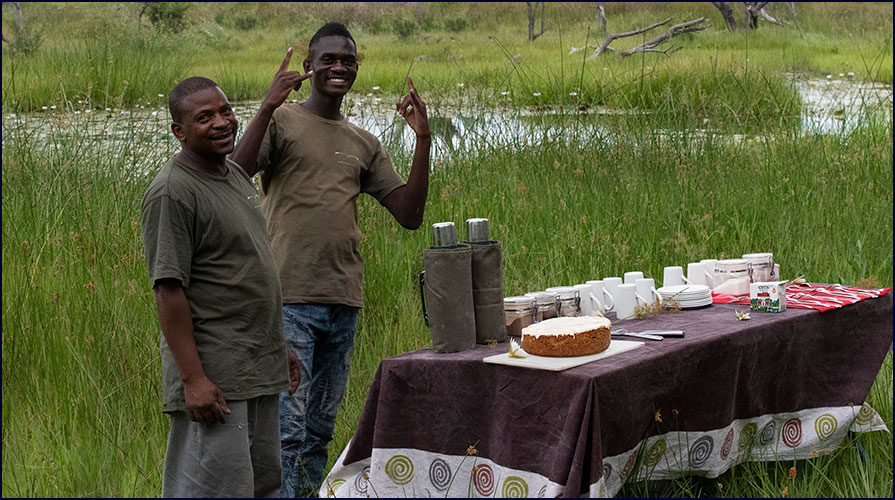
BD and KK |
We drove around a turn just past the old camp, and to our
total amazement the guys were waiting there with high tea for us!
BD and KK were standing by a table they had set up by the river;
KK was adorned with a twig of thistles behind his ear. They had a
fabulous carrot cake for us, along with coffee and tea. It was a
lovely surprise.
|